Sunday:
Three teachers embarked on a journey of exploration and learning as they set out for the Czech Republic, Chýně, on a job shadowing trip to familiarize themselves with the local educational system and school. The journey started with the first day, filled with anticipation and excitement.
The morning began early as we gathered at Helsinki-Vantaa Airport. The traim journey to the airport was pleasant, allowing us to share the atmosphere of anticipation and plan for the days ahead. Upon arrival at the airport, we had some waiting time, which we decided to spend at the airport lounge. There, we enjoyed various offerings and discussed our expectations for the upcoming trip.
Finally, the awaited moment arrived as the plane took off for Prague. The journey was comfortable, and we were thrilled about what lay ahead. Upon arrival, we headed to the hotel, where we rested for a while and prepared for the program of the following days.
Before bedtime, we decided to explore the local food culture and went for pizza. At the pizzeria, we sampled local delicacies and enjoyed the relaxed atmosphere before returning to the hotel.
The first day was full of anticipation and new experiences, and we were eager to see what the following days would bring. We were ready to learn and share our experiences with our colleagues in the Czech Republic.
Monday:
Today was a day filled with insightful experiences as we delved deeper into the Czech educational system. After breakfast, we started a journey via metro and then bus to a school located in Chýně village. This school contained a student body of around 600 pupils. However, the resources for special education were limited, with only half a special education teacher available and additional aides allocated to classrooms only upon approval from higher authorities. The special education system was quite different from our schools in Finland. Seemed like there was no such huge need for special education as in our schools in Finland.
We learned that the special education teacher takes only one student at a time, and one student gets special education teachers assistance only once a week if the need arose, so these sessions were conducted individually rather than in groups. Notably, there were no dedicated special education classrooms in this school. So the differences in special education were quite big compared to the system we have in our school.
Furthermore, the majority of teachers at the school were women, with only three men, who were primarily involved in administrative roles such as the principal or other administrative positions. Many teachers and students were amused that three male teachers were visiting their school.
Following the school introduction, we observed a math class at the elementary level. The class was a combination of students from different levels, grouped according to their proficiency. Interestingly, the higher-level math class was not taught by a regular classroom teacher but by a subject-specific teacher from secondary school.
Later, we attended a computer class where students were engaged in coding exercises. It was evident that the students were attentive and engaged, which reflected positively on the teaching methods employed.
Throughout the school day, students were not allowed to use their phones, except during designated longer breaks or in specific areas, or when explicitly permitted by the teacher during instruction. This policy greatly contributed to maintaining a conducive learning environment. This is also one thing that our schools in Finland maybe should learn from.
It was notable to observe that the students did not have many textbooks or personal laptops at their disposal. Instead, a significant portion of the instructional materials was either provided by the teacher in printed form or funded by the parents. This reliance on printed materials and parental support underscored the collaborative effort between the school and families to ensure access to educational resources. Although primary and secondary education should be free in the Czech Republic as well as in Finland.
Despite the absence of traditional textbooks and individual laptops, the students remained actively engaged and demonstrated a commendable level of participation in their lessons.
We concluded the day by enjoying a nutritious school meal, which was quite satisfying (picture below). Noticeable thing was that all the students had to pay for the launch.
For security purposes, the school doors remained locked throughout the day, and only authorized visitors, including parents, could gain access by entering the correct code on the keypad. At this, schools in Finland should also take a step forward.
Additionally, we discovered that the school had its own room where teachers could avail themselves of massage services at certain times. This initiative aimed to promote staff well-being and relaxation amidst their demanding roles in education.
Moreover, in the corridors, we noticed a vending machine where students could purchase various items such as pens or stationery if they happened to forget or run out of supplies.
In the evening, we had the opportunity to explore Prague's diverse culinary scene, rounding off the day with a delightful dining experience.
Here are some pictures from the school:
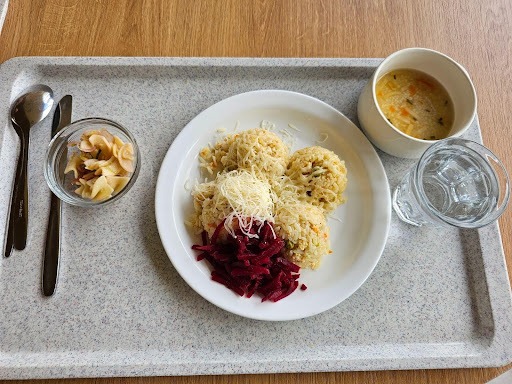
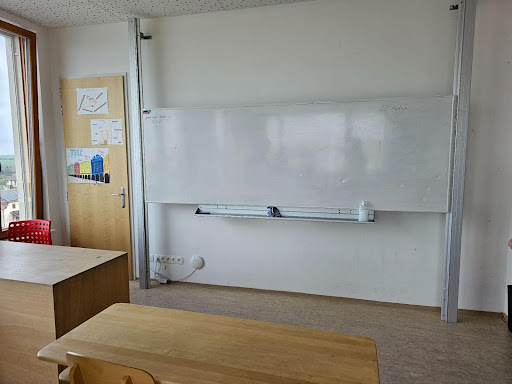
Tuesday:
Tuesday started with an insightful English lesson where geography and biology were seamlessly integrated into the curriculum, focusing on the topic of rainforests. The lesson was conducted entirely in English as part of their ongoing rainforest-themed week, demonstrating their commitment to interdisciplinary learning. It was nice to witness how they utilized thematic weeks to foster multi-disciplinary learning experiences. Some of the students attended a theater performance as part of another interdisciplinary initiative, so they were missing from the normal class.
In the subsequent class, we observed a mathematics lesson tailored for gifted students at the elementary level (5th grade we think), led by a teacher specializing in secondary school mathematics. The engagement and enthusiasm displayed by the students were commendable, reflecting their dedication to learning.
Following this, we joined a 9th grade mathematics class where all students actively participated in the lesson. Notably, there were no distractions from phones or laptops, and students relied on mental calculation skills rather than calculators at the tasks. It was interesting to note that the calculators were used only for complex topics like trigonometric functions. Moreover, we learned about the collaborative teaching approach, where two teachers co-teach a class, potentially compensating for the shortage of special education teachers. This collaborative teaching model was also used for mentorship between experienced and novice educators. Unfortunately this method of collaboration was used only rarely, because of the expenses of it.
In the Czech Republic, students undergo national exams after the ninth grade, which determine their eligibility for high schools. While these exams can induce stress among students, they ensure that admission to higher education institutions is based on merit, thus maintaining fairness and equal opportunities for all. And with this system teachers have no temptation to give a student a better grade so that he has a better chance to get into a school that he/she wants to.
In the evening, we dined at a local restaurant recommended by a resident teacher. While the experience was enjoyable, it didn't quite surpass some of the culinary delights we had encountered earlier in our exploration of Prague's gastronomic scene.
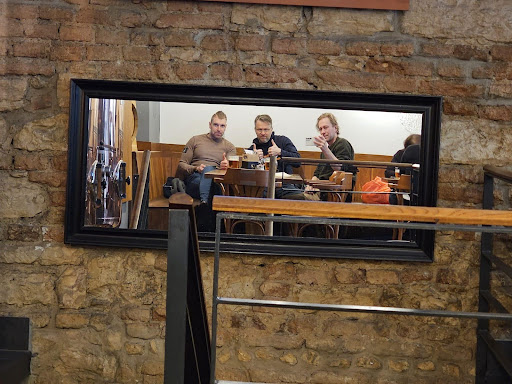
Wednesday:
On wednesday we delved deeper into the Czech educational system.
One notable aspect we encountered was the organization of physical education classes. No more than two groups were active simultaneously, ensuring optimal use of facilities. Additionally, all students came prepared with appropriate indoor sports shoes, fostering a sense of readiness in physical activities. During physical education classes, the joy of movement, spirit of competition, and emphasis on fair play were noticeable, contributing to a vibrant and inclusive learning environment.
The tradition of students standing up upon the teacher's arrival at all classes underscored the respect and discipline instilled within the school community. Students cleaning the whiteboard at the end of lessons was also a good way to show respect towards the teacher and the school community. In addition, students also assisted the kitchen staff after meals by transporting dirty dishes to their designated areas and washing them
We speculate that the well-behaved demeanor of the school's students may partially stem from a conducive home environment where rules and discipline are upheld more effectively.
According to information provided, there seems to be minimal concern regarding absenteeism in the school. One teacher said that their school had only one student in three years that had huge problems about absence at school. Allegedly, the local social services can intervene by taking a child into custody as fast as in six months if they consistently miss school. The most extreme measure involves putting the parent in jail for neglecting their child's education, although this is rarely enforced. This aspect highlights areas where our legislation and attitudes in Finland could use improvement.
A striking aspect of the Czech education system was the integration of physics, chemistry, and biology into a single subject. This departure from our traditional subject-based curriculum emphasized a different approach to science education. In my opinion, however, separating chemistry, biology, and physics into distinct subjects provides better foundations for studying the contents of sciences.
Additionally, we observed the engagement of students in verbal participation during lessons, fostering critical thinking and communication skills. The lively and interactive learning environment demonstrated the dedication of teachers to student engagement and academic success.
However, the lack of modern teaching aids like document cameras or projectors posed challenges in delivering certain lessons effectively, especially in subjects like mathematics. Most of the writing that the teacher could do, was done on the whiteboard. During chemistry class, we noticed that the equipment and facilities for student experiments were not as advanced as those in our own school. As a chemistry teacher, I couldn't help but appreciate the excellent facilities and resources available to us at our school.
The further discussion about the 9th-grade exit exam for high school revealed that the exam only covers mathematics and czech language. This prompted us to contemplate the potential challenges for students who struggle in subjects like mathematics, as their performance in these exams may significantly impact their chances of admission to their desired high school. This raises concerns about the accessibility of high school education for students with diverse strengths and talents, particularly in subjects such as languages where they may excel despite difficulties in other areas like mathematics.
Teachers and students alike have expressed daily surprise at the presence of three male teachers among them. They inquire whether it's common for men to be teachers in our country, as male teachers appear to be relatively rare in this region. That is because the salary of teachers is not that good in the Czech republic. We told them that even though in our school there are quite many male teachers, it is still a little more common to have more female teachers than male ones.
Overall, Wednesday provided a comprehensive overview of the Czech educational system, highlighting both its strengths and areas for improvement. Our interactions with teachers and students further underscored the value of cultural exchange and collaboration in shaping educational practices worldwide.

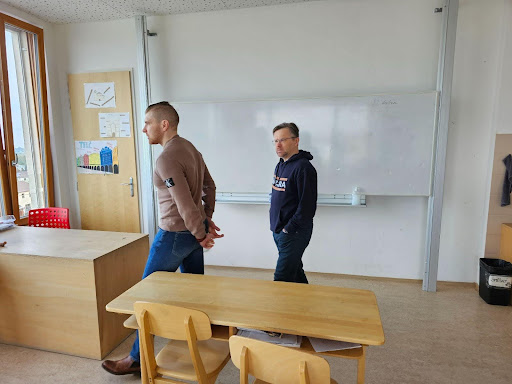
Thursday:
Thursday presented us with a delightful assignment from the school principal and teachers: to explore various classical sites in Prague, such as the cathedral area, the historic bridges over the river, and the Old Town. We were also encouraged to indulge in traditional Czech cuisines at local restaurants.
Throughout the day, we went on a walking tour, covering approximately 15 kilometers, much like the previous three days. It was an enriching experience to immerse ourselves in the rich history and cultural heritage of Prague, marveling at its architectural wonders and iconic landmarks.
After familiarizing ourselves with the culinary delights of Czech cuisine, we spent the evening shopping for gifts at the shopping centers for our loved ones.
As the sun set over the picturesque cityscape of Prague, we reflected on the many experiences of our educational journey, grateful for the opportunity to explore, learn, and grow together in this wonderful city.

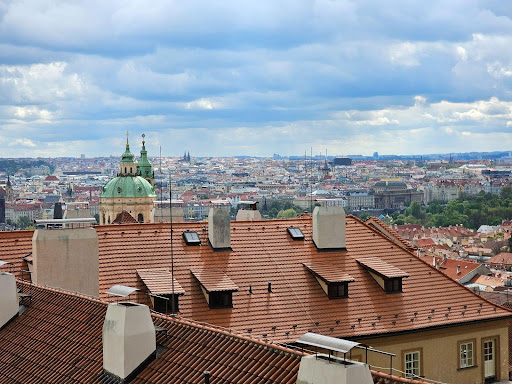

Friday:
On Friday, we traveled to school for the last time. We briefly met with the principal and chatted with the school's exchange coordinator about our experiences. It was nice to talk and exchange final news. We also took photos, exchanged gifts, and wrote entries in the guestbook.
We wish all the best to our friends in Chýně!
Tomorrow, our journey back home begins in the early hours, and next week, we'll return to our normal school routine back at home.
